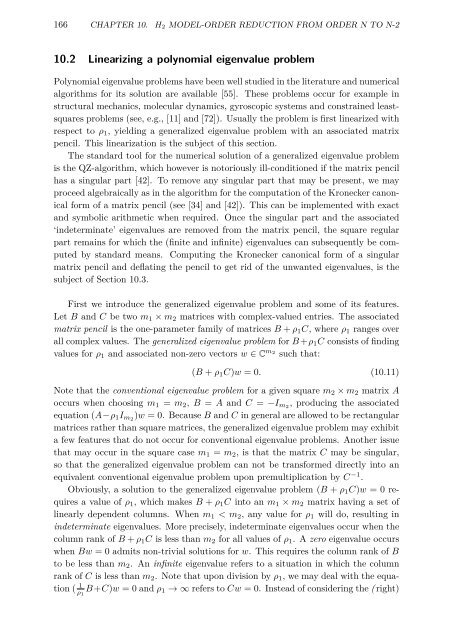link to my thesis
link to my thesis
link to my thesis
Create successful ePaper yourself
Turn your PDF publications into a flip-book with our unique Google optimized e-Paper software.
166 CHAPTER 10. H 2 MODEL-ORDER REDUCTION FROM ORDER N TO N-2<br />
10.2 Linearizing a polynomial eigenvalue problem<br />
Polynomial eigenvalue problems have been well studied in the literature and numerical<br />
algorithms for its solution are available [55]. These problems occur for example in<br />
structural mechanics, molecular dynamics, gyroscopic systems and constrained leastsquares<br />
problems (see, e.g., [11] and [72]). Usually the problem is first linearized with<br />
respect <strong>to</strong> ρ 1 , yielding a generalized eigenvalue problem with an associated matrix<br />
pencil. This linearization is the subject of this section.<br />
The standard <strong>to</strong>ol for the numerical solution of a generalized eigenvalue problem<br />
is the QZ-algorithm, which however is no<strong>to</strong>riously ill-conditioned if the matrix pencil<br />
has a singular part [42]. To remove any singular part that may be present, we may<br />
proceed algebraically as in the algorithm for the computation of the Kronecker canonical<br />
form of a matrix pencil (see [34] and [42]). This can be implemented with exact<br />
and symbolic arithmetic when required. Once the singular part and the associated<br />
‘indeterminate’ eigenvalues are removed from the matrix pencil, the square regular<br />
part remains for which the (finite and infinite) eigenvalues can subsequently be computed<br />
by standard means. Computing the Kronecker canonical form of a singular<br />
matrix pencil and deflating the pencil <strong>to</strong> get rid of the unwanted eigenvalues, is the<br />
subject of Section 10.3.<br />
First we introduce the generalized eigenvalue problem and some of its features.<br />
Let B and C be two m 1 × m 2 matrices with complex-valued entries. The associated<br />
matrix pencil is the one-parameter family of matrices B + ρ 1 C, where ρ 1 ranges over<br />
all complex values. The generalized eigenvalue problem for B +ρ 1 C consists of finding<br />
values for ρ 1 and associated non-zero vec<strong>to</strong>rs w ∈ C m2 such that:<br />
(B + ρ 1 C)w =0. (10.11)<br />
Note that the conventional eigenvalue problem for a given square m 2 × m 2 matrix A<br />
occurs when choosing m 1 = m 2 , B = A and C = −I m2 , producing the associated<br />
equation (A−ρ 1 I m2 )w = 0. Because B and C in general are allowed <strong>to</strong> be rectangular<br />
matrices rather than square matrices, the generalized eigenvalue problem may exhibit<br />
a few features that do not occur for conventional eigenvalue problems. Another issue<br />
that may occur in the square case m 1 = m 2 , is that the matrix C may be singular,<br />
so that the generalized eigenvalue problem can not be transformed directly in<strong>to</strong> an<br />
equivalent conventional eigenvalue problem upon premultiplication by C −1 .<br />
Obviously, a solution <strong>to</strong> the generalized eigenvalue problem (B + ρ 1 C)w = 0 requires<br />
a value of ρ 1 , which makes B + ρ 1 C in<strong>to</strong> an m 1 × m 2 matrix having a set of<br />
linearly dependent columns. When m 1

















